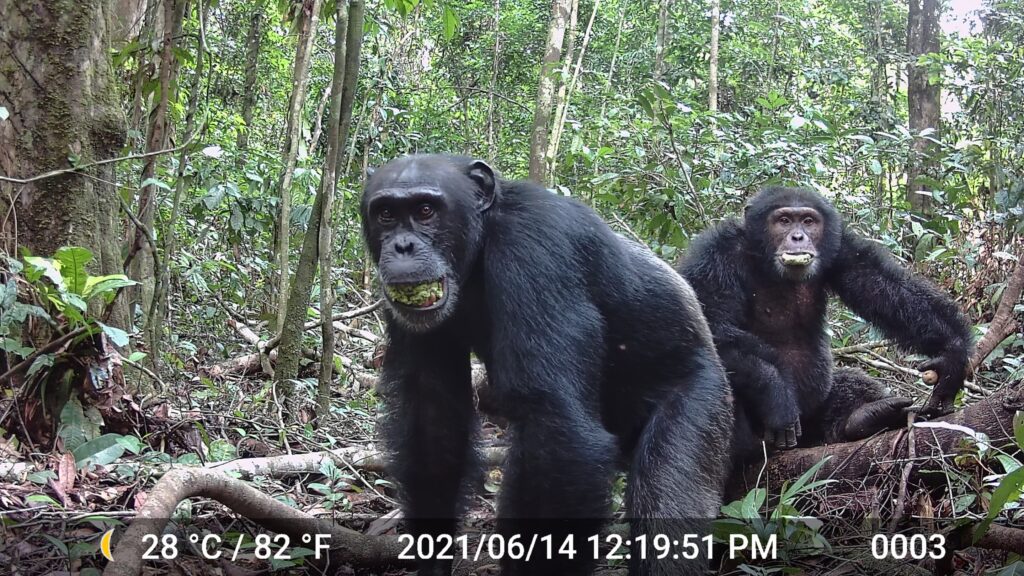
The first-ever measurements of ethanol content in fruits available to chimpanzees in their native African habitats reveal that these primates could be consuming the equivalent of more than two standard alcoholic drinks each day. This discovery, made by researchers at the University of California, Berkeley, suggests that alcohol may be a regular part of chimpanzees’ diets and possibly that of our human ancestors.
According to the study, chimpanzees ingest about 14 grams of pure ethanol daily, equating to one standard American drink. However, when adjusted for body mass, this amount rises to nearly two drinks. “Across all sites, male and female chimpanzees are consuming about 14 grams of pure ethanol per day in their diet,” said Aleksey Maro, a UC Berkeley graduate student. “When you adjust for body mass, because chimps weigh about 40 kilos versus a typical human at 70 kilos, it goes up to nearly two drinks.”
Understanding Chimpanzee Alcohol Consumption
The study involved sampling 21 species of fruit from two chimpanzee study sites—Ngogo in Uganda and Taï in Ivory Coast. These fruits had an average alcohol content of 0.26% by weight. Primatologists estimate that chimpanzees consume about 10 pounds (4.5 kilograms) of fruit per day, which constitutes about three-quarters of their diet.
Robert Dudley, a UC Berkeley professor, explained, “The chimps are eating 5 to 10% of their body weight a day in ripe fruit, so even low concentrations yield a high daily total—a substantial dosage of alcohol.” Despite this intake, chimpanzees show no overt signs of intoxication, suggesting a chronic low-level exposure to alcohol.
The ‘Drunken Monkey’ Hypothesis
Dudley first proposed the “drunken monkey” hypothesis over two decades ago, suggesting that the human appetite for alcohol may have been inherited from primate ancestors. Although initially met with skepticism, this theory has gained traction as more evidence emerges of primates consuming fermented fruit.
Recent studies have documented similar behaviors in other primates, such as spider monkeys in Panama and captive aye-ayes and slow lorises, which show preferences for higher alcohol content in nectar. Dudley noted, “The consumption of ethanol is not limited to primates. It’s more characteristic of all fruit-eating animals and, in some cases, nectar-feeding animals.”
Research Methodology and Findings
Beginning in 2019, Maro conducted fieldwork in Uganda and Côte d’Ivoire, collecting fruit samples from areas frequented by chimpanzees. The samples were analyzed for alcohol content using various methods, including a semiconductor-based device, a portable gas chromatograph, and a chemical test. The findings showed that the most frequently consumed fruits had the highest alcohol content.
Weighted by the proportion of time chimps eat each type of fruit, the average alcohol content was 0.32% by weight at Ngogo and 0.31% at Taï. “I think the strength of Aleksey’s approach is that it used multiple methods,” Dudley said. “This dataset has not existed before, and it has been a contentious issue.”
Implications and Future Research
The study provides a foundation for further research into chimpanzee dietary habits and their preference for fermented fruit. This summer, Maro returned to Ngogo to collect urine samples from chimps to analyze for alcohol metabolites, a process requiring innovative methods like using an umbrella to collect samples from chimps sleeping in trees.
The research team, including co-authors from the University of Texas, Austin, the Taï Chimpanzee Project, and the University of Michigan, aims to explore the evolutionary background of alcohol consumption. Dudley emphasized the need for additional research funding, stating, “It likely has a deep evolutionary background.”
This study not only sheds light on the dietary habits of chimpanzees but also suggests a possible link to human attraction to alcohol, rooted in our shared ancestry with these primates. As research continues, it may provide further insights into the evolutionary aspects of alcohol consumption in both humans and animals.







